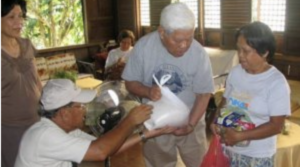Wartime, The Leader And The Sons
After 10 years working with the steamship lines, he resigned and accepted the job as a traveling salesman for the Bazar Siglo XX, a hardware company also owned by Don Yangco; He stayed there until the Second World War broke out on December 8, 1941. When Bazar Siglo XX closed, he brought his family back to Inicbulan. At that time, his oldest son Eliodoro was a practicing lawyer and was sharing offices in Heacock building in Escolta, Manila with two of his friends and old classmates: Renato Tayag and Ferdinand E. Marcos. The law offices closed too because the three lawyers were all called for active duty.
Eliodoro brought his family to Inicbulan as well. Then he went back to Manila to report for active duty. The road proved perilous. He reached Calumpang on horseback then took horse driven carts because there was no more public transportation. Most of the bridges had already been blown so when he had to cross rivers, people would carry him across. When he reached “Paliko” river, he met the family of Miss Concepcion Tolentino (his teacher in Batangas High School) and Engineer and Mrs. Magbuhat. They were on their way to Batangas but their car couldn’t make it across the blown bridge. So, they decided to turn back to Manila and invited Eliodoro to join them in spite of being overloaded.
Eliodoro reached Manila and went directly to the tailor shop in Intramuros where his uniform was being made. To his dismay his uniform was not finished because the shop was damaged when the Japanese bombed the adjacent Santo Domingo church. When he finally got his uniform, he quickly reported to the mobilization center at FEU. He noticed at FEU that there was only one bus left and it had just been filled with soldiers ready for Bataan. Among those aboard was Fernando Poe, Sr., a famous Filipino actor. Those who were left behind were told to wait for the next bus. They waited and waited for almost a day but none came. Finally, they were told that all the bridges to Bataan had already been blown by the Filipino and American forces so that the Japanese won’t be able to follow them. Those who were stranded were told to disband and go home. It took him several days to reach home.
Meanwhile, the younger brother Nemesio made it to Bataan. He was enrolled in the College of Engineering in U.P. when he was ordered to report to the Philippine Army training camp in Lipa, Batangas. He belonged to the 41st infantry regiment of the 41st division under General Lim. They were deployed along the coast of Balayan, Batangas when General McArthur ordered them to convene in Bataan.


Nemesio fought in Bataan, survived the death march and the concentration camp in Capas, Tarlac. He suffered hunger, dysentery, and malaria. When the sickly prisoners were released in August 1942, he was one of them. He recuperated at the Red Cross hospital in Bauan. When he recovered, he formed a guerilla movement in Inicbulan and Rizal to continue fighting the Japanese.
In more than three years under the Japanese occupation, Nicanor remained the elected leader of Inicbulan and Rizal because of his wise and diplomatic handling of the enemies. He was able to protect the people from the marauding Japanese soldiers who would come from the camps in Calumpang and Guintuan to demand foods and supplies from the public to feed their soldiers. Nicanor had to be very clever and tactful in dealing with the Japanese because while he danced with the enemies, his four sons were secretly active in guerilla activities.
After New Year in 1945 most of the inhabitants of Bauan had evacuated to the island of Mindoro to escape the Japanese. On February 28, 1945, those who remained in town were rounded up by the Japanese and were confined inside the church.


Most of the men were incarcerated in the house of one Severino Bautista (Nieves). The soldiers then blew up the house and the church and those who tried to escape were machine-gunned. It was a complete massacre. Everyone feared that Inicbulan and Rizal would be next.


